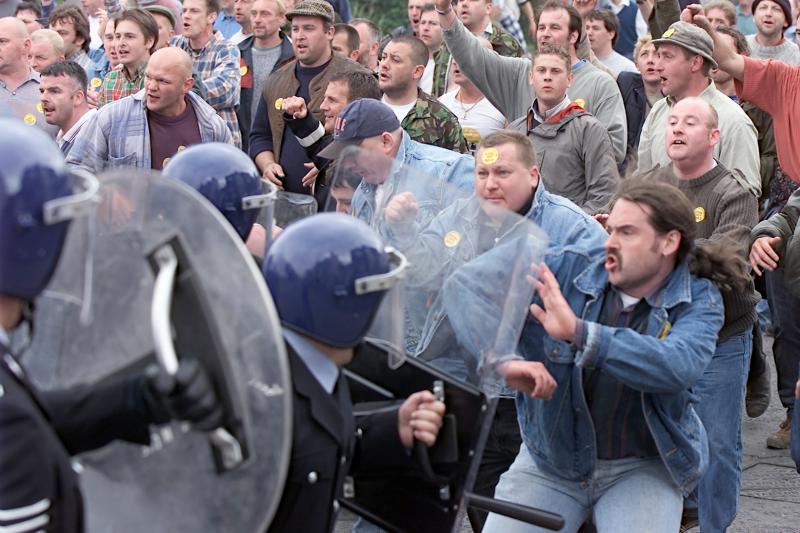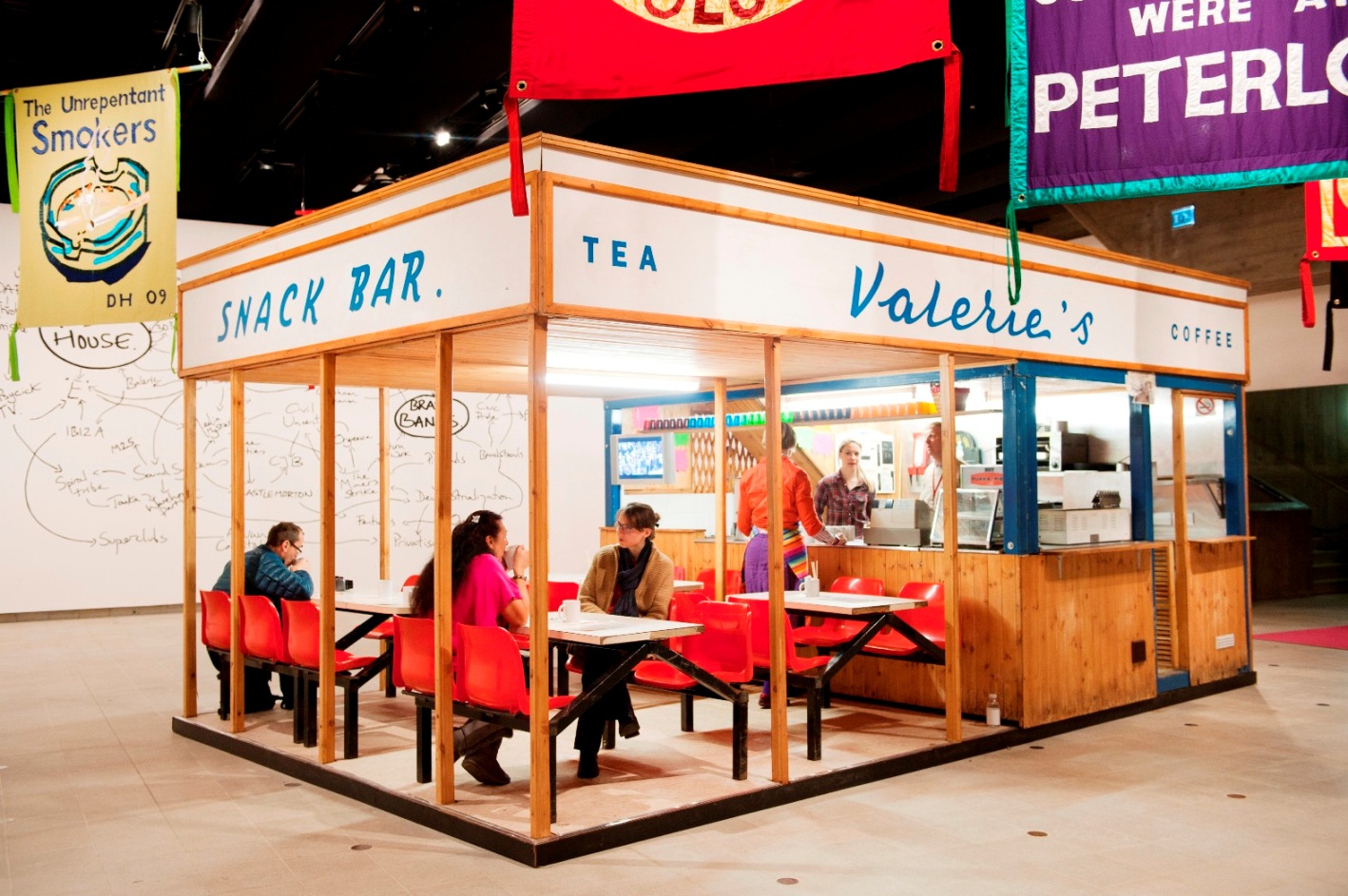Jeremy Deller: Joy in People, Hayward Gallery | reviews, news & interviews
Jeremy Deller: Joy in People, Hayward Gallery
Jeremy Deller: Joy in People, Hayward Gallery
A gallery may not be the best place to see the work of an artist whose interests are primarily people and communities

As he readily acknowledges himself, Jeremy Deller can’t paint and he can’t draw, so he never went to art school. For many artists of his generation (he’s 46), this lack of traditionally based skills seems not to have presented a problem. But Deller clearly isn’t one for trying to be good at things he’s so self-evidently bad at, so instead of going to art school he studied art history, and then began to follow his interests.
Deller’s interests are diverse, but are primarily based on an interest in people and in communities. He also likes collecting things, archiving things and facilitating “happenings” or performances. These “happenings” seem not to have anything in common with what one might usually associate with the term – firstly because they’re so highly structured, and secondly because they involve ordinary people and not art people. And because there’s nothing alienatingly avant-garde or confrontational about them they present an ideal of Nineties inclusivity rather than Sixties radicalism. Plus they’re incredibly ambitious in scale.
Deller has a remarkable talent for homing in on events that have resonance in the collective memory
The work for which Deller is best known is his 2001 performative piece, The Battle of Orgreave (main picture), which was the full-scale re-enactment of the violent clash between police and striking miners that took place in 1984 during the miner’s strike. Complete with a timeline of the key events of the strike – which is utterly absorbing – this forms the centrepiece of a survey that takes us from a loose reconstruction of Deller’s very first “exhibition” in 1993, held in his old, preternaturally tidy bedroom at his parents' house while they were away (posters, printed T-shirts, a homage to Keith Moon: reconstruction pictured below), to his latest work, Exodus, a 3D film showing thousands of bats swarming out of a cave as dusk descends.
 This latest work returns Deller to the climactic scene of Memory Bucket, his 2003 Turner Prize-winning film surveying the landscape and some of the communities of Waco, Texas, a city that provided the home and official base for George W. Bush during his presidency but which gained particular notoriety for its association with David Koresh, the Branch Davidians and the 1993 hostage siege that ended in conflagration and the deaths of 74 people. It’s a work that amply demonstrates the key thing about Deller, of just why the idea – so audacious and so imaginative that you wonder just why nobody has ever thought to do it in quite that way before – is often far more powerful than the execution.
This latest work returns Deller to the climactic scene of Memory Bucket, his 2003 Turner Prize-winning film surveying the landscape and some of the communities of Waco, Texas, a city that provided the home and official base for George W. Bush during his presidency but which gained particular notoriety for its association with David Koresh, the Branch Davidians and the 1993 hostage siege that ended in conflagration and the deaths of 74 people. It’s a work that amply demonstrates the key thing about Deller, of just why the idea – so audacious and so imaginative that you wonder just why nobody has ever thought to do it in quite that way before – is often far more powerful than the execution.
Deller has a remarkable talent for homing in on events that have particular resonance in the collective memory – staging mass street parades, getting Manic Street Preacher fans to pour out their feelings of identification with their idols, being wittily subversive by responding to a London Underground commission with a picture of a bicycle executed in the colours of an underground map, typing out the erudite graffiti found on the walls of the British Library and sticking it all on the walls of an installed toilet.
 But we don’t really need to be there to appreciate what it’s doing and how it’s working on us. In fact, the work often absorbs us more satisfactorily as a heady conceit than as something that can be properly appreciated in the real world – Deller, it seems, might just be the Borges of contemporary art, and these works really exist best in a kind of parallel universe of the mind, where they have just enough room to expand and enrich.
But we don’t really need to be there to appreciate what it’s doing and how it’s working on us. In fact, the work often absorbs us more satisfactorily as a heady conceit than as something that can be properly appreciated in the real world – Deller, it seems, might just be the Borges of contemporary art, and these works really exist best in a kind of parallel universe of the mind, where they have just enough room to expand and enrich.
And who doesn’t love the idea of Procession (2009), in which numerous “outsider” groups were invited to participate in a big street parade, from Big Issue vendors and Emos to buskers and unrepentant smokers? Or the almost exact replica of Valerie’s Snack Bar – a youth club for OAPs, as Deller describes it – which was put on the back of a lorry and given a spin as part of the whole jamboree? You’ll find it parked up at the Hayward where it serves real tea (so English and reassuring in its cosy eccentricities – conceptual art, but not as we usually know it).
All this explains why a gallery just isn’t the best place to appreciate what Jeremy Deller does; there’s something almost inevitable about its disappointment. And like his lack of drawing skills, Deller probably knows this himself.
- Jeremy Deller: Joy in People at the Hayward Gallery until 13 May
rating
Explore topics
Share this article
The future of Arts Journalism
You can stop theartsdesk.com closing!
We urgently need financing to survive. Our fundraising drive has thus far raised £49,000 but we need to reach £100,000 or we will be forced to close. Please contribute here: https://gofund.me/c3f6033d
And if you can forward this information to anyone who might assist, we’d be grateful.

Subscribe to theartsdesk.com
Thank you for continuing to read our work on theartsdesk.com. For unlimited access to every article in its entirety, including our archive of more than 15,000 pieces, we're asking for £5 per month or £40 per year. We feel it's a very good deal, and hope you do too.
To take a subscription now simply click here.
And if you're looking for that extra gift for a friend or family member, why not treat them to a theartsdesk.com gift subscription?
more Visual arts
 'We are bowled over!' Thank you for your messages of love and support
Much-appreciated words of commendation from readers and the cultural community
'We are bowled over!' Thank you for your messages of love and support
Much-appreciated words of commendation from readers and the cultural community
 Folkestone Triennial 2025 - landscape, seascape, art lovers' escape
Locally rooted festival brings home many but not all global concerns
Folkestone Triennial 2025 - landscape, seascape, art lovers' escape
Locally rooted festival brings home many but not all global concerns
 Sir Brian Clarke (1953-2025) - a personal tribute
Remembering an artist with a gift for the transcendent
Sir Brian Clarke (1953-2025) - a personal tribute
Remembering an artist with a gift for the transcendent
 Emily Kam Kngwarray, Tate Modern review - glimpses of another world
Pictures that are an affirmation of belonging
Emily Kam Kngwarray, Tate Modern review - glimpses of another world
Pictures that are an affirmation of belonging
 Kiefer / Van Gogh, Royal Academy review - a pairing of opposites
Small scale intensity meets large scale melodrama
Kiefer / Van Gogh, Royal Academy review - a pairing of opposites
Small scale intensity meets large scale melodrama
 Jenny Saville: The Anatomy of Painting, National Portrait Gallery review - a protégé losing her way
A brilliant painter in search of a worthwhile subject
Jenny Saville: The Anatomy of Painting, National Portrait Gallery review - a protégé losing her way
A brilliant painter in search of a worthwhile subject
 Abstract Erotic, Courtauld Gallery review - sculpture that is sensuous, funny and subversive
Testing the boundaries of good taste, and winning
Abstract Erotic, Courtauld Gallery review - sculpture that is sensuous, funny and subversive
Testing the boundaries of good taste, and winning
 Edward Burra, Tate Britain review - watercolour made mainstream
Social satire with a nasty bite
Edward Burra, Tate Britain review - watercolour made mainstream
Social satire with a nasty bite
 Ithell Colquhoun, Tate Britain review - revelations of a weird and wonderful world
Emanations from the unconscious
Ithell Colquhoun, Tate Britain review - revelations of a weird and wonderful world
Emanations from the unconscious
 Rachel Jones: Gated Canyons, Dulwich Picture Gallery review - teeth with a real bite
Mouths have never looked so good
Rachel Jones: Gated Canyons, Dulwich Picture Gallery review - teeth with a real bite
Mouths have never looked so good
 Yoshitomo Nara, Hayward Gallery review - sickeningly cute kids
How to make millions out of kitsch
Yoshitomo Nara, Hayward Gallery review - sickeningly cute kids
How to make millions out of kitsch
 Hamad Butt: Apprehensions, Whitechapel Gallery review - cool, calm and potentially lethal
The YBA who didn’t have time to become a household name
Hamad Butt: Apprehensions, Whitechapel Gallery review - cool, calm and potentially lethal
The YBA who didn’t have time to become a household name

Add comment